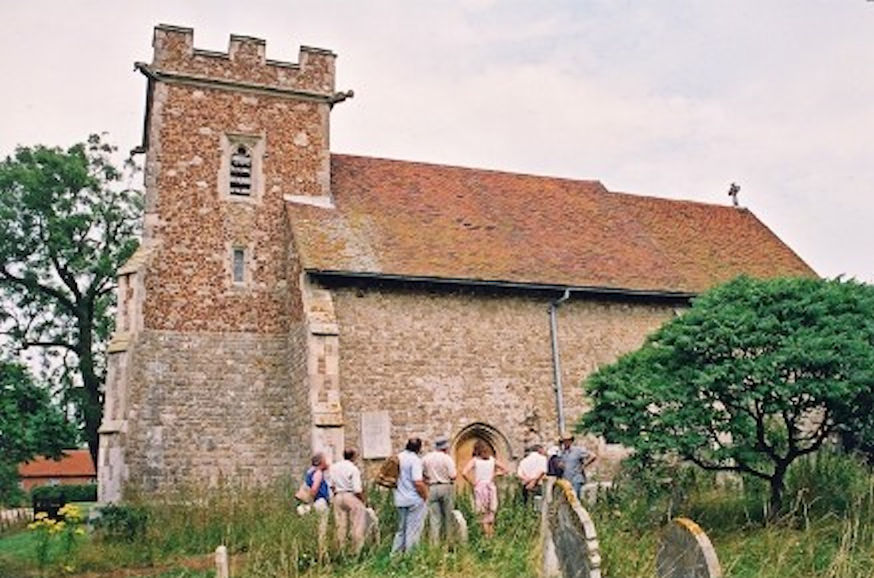The following sites have been selected to represent the different aspects of geology and landscape in the district. Not all sites have something to see; many are solely of historical interest as a record of an important or interesting discovery.
Some sites are not strictly geological but have a geological connection. Geological sites are therefore defined in their widest sense and include, for example, buildings, walls, wells, spas, springs, graves, boreholes, plaques, landslips and viewpoints.
This is not a complete list of geological sites in the district. Others will be added and descriptions expanded as further research is carried out.
Important note:
Not all of the sites here described are accessible. Some sites are on private land and can only be viewed from footpaths that pass through or alongside the site. Inclusion of a site on this list does not, therefore, imply any right of access. Please remember not to trespass on private land.
Sites of Special Scientific Interest (SSSIs)
EAST MERSEA. Coopers Beach (‘Restaurant Site’) (part of Colne Estuary SSSI) (TM 053136)
Beneath the beach shingle here is a ‘channel’ infilled with sediments dating from the Ipswichian interglacial period (125,000 years old) containing fossils including hippopotamus bones (see also Cudmore Grove, East Mersea). The sediments are beneath the beach and therefore not normally accessible.
EAST MERSEA. Cudmore Grove Cliffs and Foreshore (part of Colne Estuary SSSI) (TM 068 146)
The cliffs at Cudmore Grove Country Park provide superb exposures of gravels laid down by the Thames-Medway River during a glacial period 300,000 years ago. Organic sediments at beach level sometimes yield fossils, including mammal bones, that indicate that they were deposited during an interglacial period. Also exposed on the foreshore are deposits from a more recent interglacial period, the Ipswichian interglacial (120,000 years old), and known as the ‘hippo site’ due to the presence of hippopotamus bones. (see also East Mersea Coopers Beach (‘Restaurant site’).
MARKS TEY. Marks Tey Brick Pit SSSI (TL 911 243)
Marks Tey Brick Pit provides exposures of uniquely important Pleistocene sediments, which have yielded a continuous pollen record through the entire Hoxnian Interglacial period (400,000 years ago). No other site in the British Isles has so far produced a comparable vegetational record for this or any other interglacial. Of considerable interest also are the laminations (seasonal layers) within these lacustrine (lake) sediments which have made it possible to estimate the duration in years of the Hoxnian Interglacial. Private land. Permission to visit is required from the brick company.
WIVENHOE. Wivenhoe Gravel Pit SSSI (TL 050 235)
The SSSI is the type locality for the Wivenhoe Gravel, a gravel deposited by the early Thames during two cold stages of the Ice Age. Interbedded with the gravel is an interglacial deposit containing fossils from a warm or temperate climate. Humanly-worked flint flakes have also been found. The deposits are over 500,000 years old. The conserved area of the SSSI is an overgrown flooded depression just inside the Colchester district. Restoration plan for part of quarry includes a fine sandmartin cliff at TM 0505 2202. Private land. Permission to visit is required from the quarry owners.
Local Geological Sites (LoGS)
FINGRINGHOE. Fingringhoe Wick Nature Reserve (TM 045 195)
Essex Wildlife Trust nature reserve. Fingringhoe Wick was a working gravel quarry until 1959. Visible in many places are mounds and banks of glacial sand and gravel (known locally as Upper St. Osyth Gravel) which was deposited some 450,000 years ago by torrents of meltwater issuing from the Anglian ice sheet, the edge of which was then situated only 12 kilometres west of here. The gravel therefore provides evidence of an exceptionally cold period of the Ice Age. A permanent vertical section through the gravel exists in the centre of the reserve.
Other Sites
COLCHESTER. Colchester Castle (TL 998 253)
Colchester Castle (a Norman keep) is constructed of septarian nodules (septaria) from the London Clay, probably gathered from the Essex coast.
COLCHESTER. Lion Walk United Reformed Church spire (formerly Colchester Congregational Church) (TL 9971 2506)
The top of the church spire fell into the street during the 1884 earthquake and the Illustrated London News at the time published an impressive engraving of the occurrence with people fleeing from the scene. The church has since been demolished but the tower (with its rebuilt spire) was spared and it remains as a prominent landmark in the town shopping centre. It is the tallest church spire in Colchester.
COLCHESTER. St. John’s Abbey Gatehouse (TL 9977 2475)
The fifteenth century gatehouse of St. John’s Abbey is a fine example of the use of knapped flints known as ‘flushwork’.
COLCHESTER. The Greenstead Boulders (TM 022 248)
A sarsen (0.9 x 0.9 metres in size) stands upright next to a bus stop in Avon Way (TM 0231 2483). About 150 metres to the west of the sarsen stone, a fine colourful boulder of Hertfordshire puddingstone (1.5 x 0.75 metres in size) can be seen sitting on a concrete plinth a few metres from the pavement (TM 0216 2481) (unfortunately now enclosed by a communal garden). This puddingstone is a puzzle as it is in mint condition and shows no sign of being transported by a river or an ice sheet. Greenstead housing estate was built in the 1960s. These stones are the only erratic boulders in Essex in an urban setting.
COLCHESTER. Roman Town Wall (TL 9942 2550)
Colchester’s Roman Wall is constructed of septarian nodules (septaria) from the London Clay, probably gathered from the Essex coast. The septaria are interspersed with layers of brick. The wall was probably constructed in the late 3rd century.
COPFORD. Pits Wood (also known as Gravelpit Wood) (TL 931 234)
Local wildlife site situated in old gravel workings. Wood open to the public. Kesgrave (pre-diversion Thames) sand and gravel visible in banks and thrown out from animal burrows.
DEDHAM. Jupes Hill Landslip (TM 069 318)
Landslip in the London Clay slopes on the south side of the Stour valley near Dedham. It is reported to have occurred in 1928 on a slope of between 9° and 11½° between the 100 and 65 foot contours. An area of about 260 feet across the slope and 260 feet down was involved in the movement which left a rear scarp of about 8 feet in height. The toe of the slope has now been ploughed away. The Essex Way passes across the top of the landslip. Historical site only as little evidence of the landslip can now be seen. There is evidence of larger, older landslips along this side of the valley.
EAST MERSEA. Deremy’s Stone (TM 037 142)
Opposite the Old Rectory, on the East Mersea Road, by the East Mersea sign, is a rounded boulder of basalt, 70 x 70 x 35 centimetres in size, known locally as Deremy’s Stone. It is claimed to have been dug up on this spot in 1974. It is provided with a plaque stating that it was placed here to define the boundary of the manor of West Mersea granted by Edward the Confessor in 1046.
FORDHAM. Rams Farm Sarsen Stone (TL 934 288)
At Rams Farm is a fine sarsen stone, 130 x 110 x 50 cm in size, standing upright by the roadside. The boulder was moved to its present position in the 1960s.
GREAT HORKESLEY. Greenbank House Sarsen Stones (TL 981 321)
Four sarsen stones are situated by the entrance to Greenbank House in Boxted Church Road near the junction with Holly Lane. Each is about 90 x 60 x 40 cm in size and they can be clearly seen from the roadside. The garden of the house contains over 20 sarsens, each one brought here by the owner from farmland in the nearby Stour Valley. Greenbank House is a private residence.
LEXDEN. Lexden Springs Nature Reserve (TL 973 253)
In Spring Lane, off Lexden Road, is a patch of ancient meadowland which is generally rich in wild flowers. Here a natural spring issues from the junction of the Kesgrave Sands and Gravels and the underlying London Clay.
LITTLE WIGBOROUGH. St. Nicholas Church (TL 980 145)
This 15th century church was badly damaged in the 1884 earthquake, the roof was completely stripped of its tiles and several pieces of masonry fell from the tower. Although over 1,200 buildings in east Essex suffered badly, it is one of the few that was photographed at the time and can still be recognised today. Inside the building a brass plaque on the wall of the tower commemorates this event and the rebuilding of the church in 1886.
PELDON. Rose Inn (TL 006 159)
Peldon was at the epicentre of the 1884 earthquake. The Rose Inn was particularly badly damaged and there are numerous contemporary illustrations and photographs of the building soon after the event. A plaque at the rear of the building (installed by the Rural Community Council of Essex in the 1980s) commemorates the earthquake.
PELDON. St. Mary’s Church
Peldon Church was situated at the epicentre of the 1884 Colchester earthquake and was badly damaged. The bricked-up nave bearing evidence of the extensive repair work undertaken.
STANWAY. Grave of John Brown
In Stanway churchyard is the grave of the most famous Essex geologist John Brown (1780-1859), whose collection of nearly 8.000 specimens was bequeathed to the Natural History Museum in London. The grave is unfortunately now covered in lichen and moss and the inscription is barely readable.
WAKES COLNE GREEN. Wakes Colne Green Sarsen Stones (TL 897 300)
At the road junction are three sarsen stones by a pond, the largest 100 x 100 x 30 cm in size.

